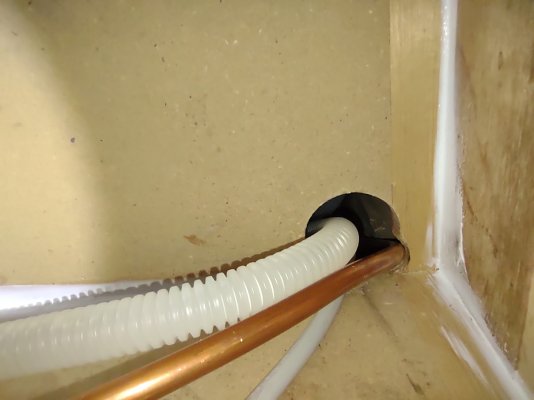JoeWras
Give me a museum and I'll fill it. (Picasso) Give me a forum ...
- Joined
- Sep 18, 2012
- Messages
- 11,702
A few years ago I solicited ideas for a redesign of our first floor. They were awesome! We've since decided to stay with our current design, which includes a nearly 45 year old kitchen. The layout isn't terrible and I don't want to just toss everything and add to the landfill. The cabinets are solid, but just a little old fashioned in design.
I'm resigned to find a way to spruce up the finish of our semi-custom cabinets in the kitchen. That's another topic. What I recently discovered while working on some dishwasher drainage was that our cabinets are sealed terribly. Some have open backs and various holes. This allows pests of all sorts to have runways to work with. We have eliminated the mice. But... living in the southeast USA means we have, uh, roaches of various species. It just isn't possible to eliminate them unless you soak the home in pesticides, which is not my thing. They live outside and find a way in.
These old tyme cabinets stink. I'm working on fixing the totally open backs with various solutions (new panels, expanding foam). But what about the dishwasher drain/supply pass throughs?
Dishwashers fail on a regular basis now, so I want to be able to seal these pass-through holes with something temporary. I could put expanding foam in these holes, but it is a pain to cut out the next time a new dishwasher comes. And the installers will throw up their hands if they can't move the lines.
Any ideas on a good, secure way to seal these holes in a good, but removable way? Foam? Boards? Steel wool? What ideas do you have?
Picture below:
I'm resigned to find a way to spruce up the finish of our semi-custom cabinets in the kitchen. That's another topic. What I recently discovered while working on some dishwasher drainage was that our cabinets are sealed terribly. Some have open backs and various holes. This allows pests of all sorts to have runways to work with. We have eliminated the mice. But... living in the southeast USA means we have, uh, roaches of various species. It just isn't possible to eliminate them unless you soak the home in pesticides, which is not my thing. They live outside and find a way in.
These old tyme cabinets stink. I'm working on fixing the totally open backs with various solutions (new panels, expanding foam). But what about the dishwasher drain/supply pass throughs?
Dishwashers fail on a regular basis now, so I want to be able to seal these pass-through holes with something temporary. I could put expanding foam in these holes, but it is a pain to cut out the next time a new dishwasher comes. And the installers will throw up their hands if they can't move the lines.
Any ideas on a good, secure way to seal these holes in a good, but removable way? Foam? Boards? Steel wool? What ideas do you have?
Picture below:
Attachments
Last edited:

